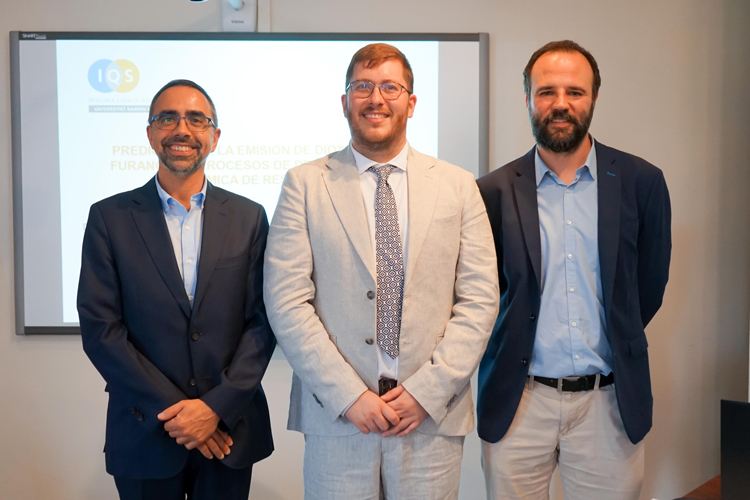Dr Damià Palmer recently defended his doctoral thesis at IQS, in which he built a mathematical model capable of predicting dioxin and furan emissions in urban waste incineration processes, making it possible to control the emissions problems associated with these processes.

Dioxins and furans are chemical compounds that fall within the family of Persistent Organic Pollutants (POPs). POPs are unwanted by-products that are generated mainly in organic material combustion processes, industrial processes, or in waste incineration, among others. They are highly toxic to living beings even at very low levels, are persistent for long periods of time, and can accumulate in the tissues of living organisms.
One of the emissions sources of these compounds is municipal solid waste (MSW) incineration plants. They represent one of the most significant environmental challenges that we must tackle as a society as around 500 kg of MSW is generated across the European Union per person per year. Managing this waste must also be adapted to the circular economy philosophy adopted by the EU in its 2030 agenda.
The formation of dioxins and furans is particularly heightened in the thermal degradation stages of waste in the post-combustion area, where both the incineration process itself and the cleaning of the gases produced increase the formation of polychlorinated dibenzo-p-dioxins and polychlorinated dibenzofurans (PCDD/PCDFs). With extremely low Emission Limit Values (ELVs) allowed, these families of molecules are very complex to analyse continuously and in real time during the aforementioned incineration and cleaning processes for the emissions gases.
It is within this context that Dr Damià Palmer conducted his doctoral thesis at IQS, in which he has established a mathematical model for predicting the emissions of PCDD/PCDFs in incineration processes and making it possible to control the associated environmental issues. Entitled Prediction of the emission of dioxins and furans during processes of thermal degradation of waste, his thesis was conducted within the GESPA group (Environmental Processes Engineering and Simulation Group) within the IQS School of Engineering and supervised by Dr Jordi Díaz and Dr Oriol Pou.
Emission prediction model in incineration processes
Thanks to the mathematical model developed in this doctoral thesis, it is possible to predict the emissions of dioxins and furans into the atmosphere taking the following parameters into account: the composition of the waste or the content of metals and chlorine and the incineration process variables such as temperature and oxygen content.
Not all dioxins and furans classified as POPs – 210 molecules in total – have the same toxicity. In order to avoid having to consider all of them and to simplify the model, Dr Palmer made a selection of seventeen PCDD/PCDF congeners beforehand, the formation of which is considered linearly independent. The selection was made with a series of data from samples of industrial origin and subsequently validated and extended with laboratory experimentation samples. The latter step was done in collaboration with the REMAN research group (Waste, Energy, Environment, and Nanotechnology) at the University of Alicante.
The mathematical prediction model was designed by combining two models: the first is a kinetic model of PCDD/PCDF formation, for which a tubular furnace was used taking into account parameters such as the ratio of oxygen necessary for combustion and residence time.
The second is a model of the incineration process to predict atmospheric emissions using ASPEN/HYSYS, which makes it possible to determine the entire balance of matter and energy and convert the amounts of PCDD/PCDFs generated (in mass produced per mass of waste incinerated) into atmospheric emissions (in mass of pollutants produced per volume of flue gas emitted under normal conditions).
In short, the model designed by Dr Palmer provides a solution to control the emissions of dioxins and furans in combustion processes in order to have data on these emissions in real time to monitor them when it is not possible to read them continuously.
Related publications
Damià Palmer, J. Oriol Pou, Jordi Diaz-Ferrero, Lucinio Gonzalez-Sabater, Multiple linear regression based congener profile correlation to estimate the toxicity (TEQ) and dioxin concentration in atmospheric emissions, Sci. Total Environ.622-623, 510-516 (2018), https://doi.org/10.1016/j.scitotenv.2017.11.344
Damià Palmer, J Oriol Pou, Lucinio Gonzalez-Sabaté, Jordi Diaz Ferrero, Juan A. Conesa, Núria Ortuño, New models used to determine the dioxins total amount and toxicity (TEQ) in atmospheric emissions from thermal processes, Energies 12 (23), 4434 (2019) http://dx.doi.org/10.3390/en12234434
Juan A. Conesa, Núria Ortuño, Damià Palmer, Estimation of industrial emissions during pyrolysis and combustion of different wastes using laboratory data, Scientific reports 10, 6750 (2020); https://www.nature.com/articles/s41598-020-63807-w
Damià Palmer, Josep Oriol Pou, Jordi Diaz Ferrero, Juan A. Conesa, Kinetics of the formation and destruction of PCDD/Fs in a laboratory tubular furnace, Chemposphere 276, 130175 (2021); http://dx.doi.org/10.1016/j.chemosphere.2021.130175
This thesis has received financing through the IQS Predoctoral Grants programme for conducting doctoral theses.










